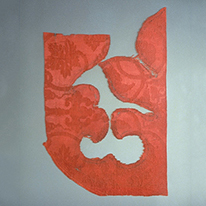Past Exhibitions
- Fragments of History: Shōsō-in gire and Other Ancient Textiles
- June 13, 2017 - July 23, 2017
In ancient times, Japanese textiles developed under the influence of the Korean Peninsula and China, especially the Korean Baekje (18 BCE–660 CE) and Goguryeo (37 BCE–668 CE) kingdoms and the Chinese Sui (581–618) and Tang (618–907) dynasties.
The textiles prized in Japan’s Asuka (592–710) and Nara (710–794) periods included woven complementary weave (nishiki), damasks (aya), and complex gauzes (ra), as well as textiles dyed with the techniques of wax resist, clamp resist, and tie-dyeing. These were either imported from the continent or produced in Japan in imitation of overseas prototypes. Today, we can grasp this history through miraculously preserved ancient textile collections such as the Hōryū-ji gire (kire or gire means “fragments” or “cloth”) from Hōryū-ji Temple and the Shōsō-in gire from Tōdai-ji Temple, both in Nara.
In addition, recent excavations in China have made it clear that even after Japanese envoys to Tang China were abolished, textiles from the Liao kingdom, which flourished in the north of China, made their way to Japan during the Heian period (794–1185).
This exhibition reveals the affection and admiration that the Japanese people have felt for these beautiful remnants of ancient textiles. Amazingly, these fragments were never buried but have been handed down as heirlooms from generation to generation for over a thousand years.












